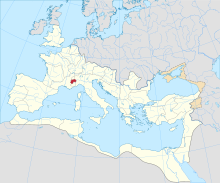Alpes Cottiae
This article includes a list of general references, but it lacks sufficient corresponding inline citations. (April 2016) |
| Provincia Alpes Cottiae | |||||||
|---|---|---|---|---|---|---|---|
| Province of the Roman Empire | |||||||
| 15 BC–476 AD | |||||||
 The Roman Empire ca. AD 125, with the province of Alpes Cottiae highlighted. | |||||||
| Capital | Segusio | ||||||
| Historical era | Antiquity | ||||||
• Created by Augustus | 15 BC | ||||||
• Deposition of Romulus Augustulus | 476 AD | ||||||
| |||||||
| Today part of | |||||||
Alpes Cottiae (Latin pronunciation: [ˈaɫpeːs ˈkɔttɪ.ae̯]) was a province of the Roman Empire, one of three small provinces straddling the Alps between modern France and Italy.[1] Its name survives in the modern Cottian Alps. In antiquity, the province's most important duty was the safeguarding of communications over the Alpine passes.
Alpes Cottiae was bordered by Gallia Narbonensis to the west, Alpes Maritimae to the south, Italia to the east, and Alpes Graiae to the north. The provincial capital was at Segusio (modern Susa in Piedmont).
History
The province had its origin in the kingdom controlled by Donnus, ruler of the local Ligurian tribes of the area in the middle of the 1st century BC, and was named after his son and successor Marcus Julius Cottius,[1] whose realm was integrated into the Roman imperial system under Augustus.[2][3]
Initially, Cottius and his successors Gaius Julius Donnus II (reigned 3 BC-4 AD) and Marcus Julius Cottius II (reigned 5-63 AD) continued to hold power as client rulers; afterwards, under Nero a procurator was appointed and it officially became a Roman province.[4] The governors of the province were prefects from the Equestrian order.
Settlements
Settlements in Alpes Cottiae included:
- Ad Fines (Malano) ("mansio", customs post)
- Ocelum (Celle) ("oppidum", Celtic village)
- Ad Duodecimum (Saint-Didier) ("mutatio")
- Segusio (Susa) (capital)
- Venausio (Venaus) (oppidum)
- Scingomagus / Excingomagus (Exilles) (oppidum, possibly Donnus's capital)
- Caesao / Goesao (Cesana Torinese) ("castrum")
- Ad Martes Ultor (late imperial "Ulcense") (Oulx) ("castrum")
- Brigantium (Briançon) (mansio)
- Mons Matronae (Mont Genèvre)
See also
References
- ^ a b Bertrand, E.; R. Talbert; S. Gillies; T. Elliott; J. Becker. "Places: 167636 (Alpes Cottiae)". Pleiades. Retrieved November 1, 2014.
- ^ Vitruvius, On architecture, 8,3,17
- ^ Goodman, M., The Roman World 44 BC–AD 180, p. 120
- ^ Bibliotheca classica or A classical dictionary, John Lemprière, G. and C. Carvill, 1831; pag. 414
- Tilmann Bechert: Die Provinzen des römischen Reiches: Einführung und Überblick. von Zabern, Mainz 1999.
- Bartolomasi : Valsusa Antica . Alzani, 1975.
- Prieur - La province romaine des Alpes Cottiennes, Lyon 1968.
45°01′00″N 6°47′03″E / 45.0167°N 6.7841°E

